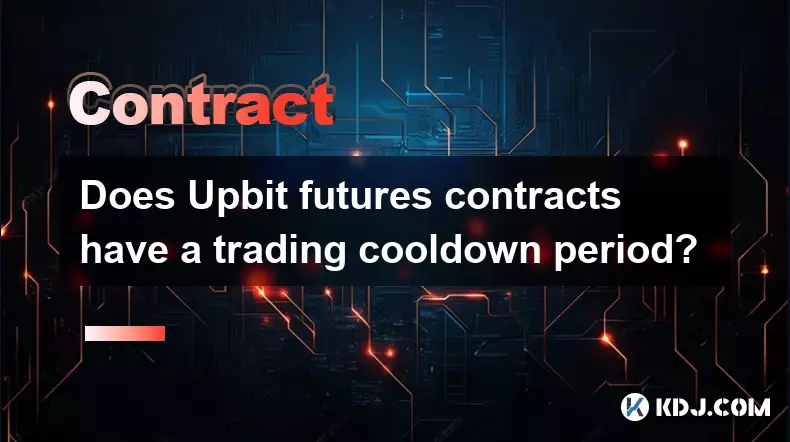-
 bitcoin
bitcoin $109667.069529 USD
-3.03% -
 ethereum
ethereum $3936.685804 USD
-4.07% -
 tether
tether $1.000493 USD
0.01% -
 xrp
xrp $2.771823 USD
-4.74% -
 bnb
bnb $957.805027 USD
-5.34% -
 solana
solana $196.735100 USD
-6.68% -
 usd-coin
usd-coin $0.999727 USD
-0.01% -
 dogecoin
dogecoin $0.227355 USD
-5.12% -
 tron
tron $0.335205 USD
-0.81% -
 cardano
cardano $0.779256 USD
-3.59% -
 ethena-usde
ethena-usde $0.999900 USD
-0.06% -
 hyperliquid
hyperliquid $42.492095 USD
-6.61% -
 chainlink
chainlink $20.501853 USD
-4.34% -
 avalanche
avalanche $28.952606 USD
-11.21% -
 stellar
stellar $0.356038 USD
-3.93%
Does Upbit futures contracts have a trading cooldown period?
Upbit does not offer futures trading, so there is no cooldown period—trading occurs in the spot market with immediate buy-sell capabilities.
Sep 19, 2025 at 12:54 am

Understanding Upbit's Futures Trading Mechanism
1. Upbit is one of the largest cryptocurrency exchanges in South Korea, known for its robust infrastructure and high trading volume. While it supports spot trading extensively, its offerings for futures contracts differ significantly from global platforms like Binance or Bybit.
2. As of now, Upbit does not officially support futures contracts trading for most international users. The platform primarily focuses on spot transactions involving Korean won (KRW) pairs. This means that features commonly associated with derivatives—such as leverage, margin accounts, or cooldown periods—are not applicable within Upbit’s current framework.
3. Some confusion arises because other exchanges use similar naming conventions or offer localized versions with derivative products. However, Upbit maintains strict compliance with South Korean financial regulations, which limits the availability of speculative instruments like futures.
4. Traders seeking futures functionality often redirect to offshore exchanges that provide 24/7 leveraged trading. These platforms may implement cooldown mechanisms to prevent excessive position flipping or reduce systemic risk during volatile markets.
No Cooldown Period Applies on Upbit for Futures
1. Since Upbit does not list tradable futures contracts, there is no cooldown period enforced after closing a position. A cooldown period typically restricts traders from re-entering a specific contract immediately after exiting, aiming to curb hyperactive trading behavior.
2. On exchanges where such rules exist, cooldown durations can range from seconds to minutes depending on contract type and market conditions. These restrictions are usually embedded in the platform’s risk management protocol.
3. In Upbit’s ecosystem, all trades occur in the spot market, meaning immediate buy-sell transitions are permitted without delay. There are no built-in timers preventing consecutive executions on the same asset pair.
4. Regulatory oversight in South Korea plays a major role in shaping these limitations. Financial authorities discourage high-leverage products due to consumer protection concerns, effectively eliminating the need for cooldown policies related to derivatives.
Differences Between Spot and Derivatives Platforms
1. Global exchanges offering futures often include advanced order types, funding rates, and liquidation engines. These systems require safeguards like cooling intervals to maintain fairness and stability across the marketplace.
2. Upbit’s architecture prioritizes transparency and accessibility for retail investors engaging in direct ownership of digital assets. It avoids complex financial engineering seen in perpetual swaps or quarterly futures.
3. Users attempting to access futures-like exposure on Upbit might explore alternative strategies using limit orders or automated bots, though these methods lack true short-selling capabilities or leverage integration.
4. The absence of a cooldown period reflects the simplicity of spot-based operations. Transactions settle rapidly, and balances update in real time, allowing seamless turnover between buys and sells.
Common Misconceptions About Trading Restrictions
1. Many assume that large-volume trades trigger temporary locks or mandatory waiting times. Upbit imposes withdrawal limits and identity verification thresholds but does not enforce trade frequency constraints.
2. Network congestion or API throttling may create delays in order execution, which some interpret as a cooldown. These are technical bottlenecks rather than policy-driven pauses.
3. Third-party tools integrating with Upbit’s API sometimes introduce intentional delays to manage request loads. These external factors should not be confused with exchange-level cooldown rules.
4. During periods of extreme volatility, Upbit may temporarily halt trading on specific pairs for maintenance or price stabilization. Such interventions affect all users equally and are unrelated to individual trading activity patterns.
Frequently Asked Questions
Q: Can I trade leveraged products on Upbit?A: No, Upbit does not offer leveraged trading or margin services. All transactions are conducted in spot mode with actual asset ownership.
Q: Are there any limits on how frequently I can trade on Upbit?A: There are no explicit frequency restrictions. Users can execute multiple trades consecutively provided they meet minimum order sizes and have sufficient balance.
Q: Why do some sources claim Upbit has futures trading?A: Confusion may stem from regional variations or misinformation. Upbit operates different versions for domestic and international audiences, but none currently support standardized futures contracts.
Q: What happens if my order fails during high volatility?A: Order failures can result from slippage, insufficient liquidity, or server latency. Upbit does not penalize failed attempts nor impose waiting periods before retrying.
Disclaimer:info@kdj.com
The information provided is not trading advice. kdj.com does not assume any responsibility for any investments made based on the information provided in this article. Cryptocurrencies are highly volatile and it is highly recommended that you invest with caution after thorough research!
If you believe that the content used on this website infringes your copyright, please contact us immediately (info@kdj.com) and we will delete it promptly.
- Coin Value Challenge: Navigating the Shifting Sands of Crypto and Tradition
- 2025-09-26 08:25:13
- XRP, Cardano, and Opportunity: Navigating the Crypto Landscape in 2025
- 2025-09-26 08:25:13
- Pepe, Price Prediction, and Returns: Is the Meme Magic Fading?
- 2025-09-26 08:45:14
- BlackRock, Bitcoin ETFs, and Yields: A New York Minute on Crypto Finance
- 2025-09-26 09:05:12
- Meme Coins in 2025: Presales, Trends, and What's Hot
- 2025-09-26 09:05:12
- Dogecoin, Price Prediction, and the Crypto Whitelist Craze: What's the Hype?
- 2025-09-26 09:10:01
Related knowledge

How do I enable the "scalping-only" mode for Cardano (ADA) contracts?
Sep 24,2025 at 03:19am
Understanding Scalping Strategies in Crypto Derivatives1. Scalping in cryptocurrency trading refers to executing multiple short-term trades within min...

What is the maximum position limit for Cardano (ADA) contracts?
Sep 23,2025 at 11:00pm
Understanding ADA Futures and Derivatives Market Structure1. Cardano (ADA) futures contracts are offered by several major cryptocurrency derivatives e...

What is the maker fee for Cardano (ADA) contracts?
Sep 26,2025 at 09:01am
Understanding Maker Fees in Cardano (ADA) Contracts1. The concept of maker fees applies broadly across decentralized exchanges and smart contract plat...

How can I view open interest in Cardano (ADA) contracts?
Sep 24,2025 at 07:36am
Understanding Open Interest in Cardano Derivatives1. Open interest refers to the total number of outstanding derivative contracts, such as futures or ...

What is the function of the insurance fund in Cardano (ADA) contracts?
Sep 24,2025 at 02:18am
Understanding the Role of Insurance Funds in Cardano Smart Contracts1. The insurance fund within Cardano's ecosystem is not a native feature directly ...

How can I view historical transaction records for Cardano (ADA) contracts?
Sep 24,2025 at 04:01pm
Understanding Cardano's On-Chain Data Structure1. Cardano operates on a proof-of-stake blockchain that records all transactions in blocks secured thro...

How do I enable the "scalping-only" mode for Cardano (ADA) contracts?
Sep 24,2025 at 03:19am
Understanding Scalping Strategies in Crypto Derivatives1. Scalping in cryptocurrency trading refers to executing multiple short-term trades within min...

What is the maximum position limit for Cardano (ADA) contracts?
Sep 23,2025 at 11:00pm
Understanding ADA Futures and Derivatives Market Structure1. Cardano (ADA) futures contracts are offered by several major cryptocurrency derivatives e...

What is the maker fee for Cardano (ADA) contracts?
Sep 26,2025 at 09:01am
Understanding Maker Fees in Cardano (ADA) Contracts1. The concept of maker fees applies broadly across decentralized exchanges and smart contract plat...

How can I view open interest in Cardano (ADA) contracts?
Sep 24,2025 at 07:36am
Understanding Open Interest in Cardano Derivatives1. Open interest refers to the total number of outstanding derivative contracts, such as futures or ...

What is the function of the insurance fund in Cardano (ADA) contracts?
Sep 24,2025 at 02:18am
Understanding the Role of Insurance Funds in Cardano Smart Contracts1. The insurance fund within Cardano's ecosystem is not a native feature directly ...

How can I view historical transaction records for Cardano (ADA) contracts?
Sep 24,2025 at 04:01pm
Understanding Cardano's On-Chain Data Structure1. Cardano operates on a proof-of-stake blockchain that records all transactions in blocks secured thro...
See all articles










































































